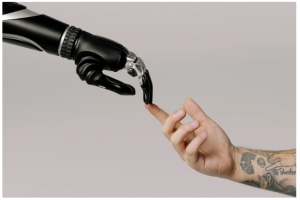
Image source: pexels.com
By James Wilson
In recent years, artificial intelligence (AI) has become an integral part of various industries, from healthcare and finance to retail and entertainment. As AI technology advances, the need for human-centered design approaches in AI-driven solutions becomes more apparent.
Designing AI systems that prioritize the needs and experiences of users is crucial to ensure their widespread adoption and overall success. In this article, we’ll talk about the significance of human-centered approaches in AI design. We’ll also discuss the benefits of human-centered approaches and practical methods for integrating human-centricity into AI-driven design solutions.
Understanding Human-Centered Design and AI
The human-centered design revolves around empathizing with users. You must involve users in the design process and craft solutions that meet their unique needs. When applied to AI, this approach emphasizes the importance of considering human values, ethics, and preferences in developing intelligent systems.
AI-driven design solutions aim to create seamless interactions between humans and machines. As AI becomes a more influential technology, it’s vital to prioritize transparency, trust, and human oversight in AI systems. This helps foster user confidence and acceptance.
Benefits of Human-Centered AI Design
Striving to achieve a human-centered design in AI brings various benefits. Some of these benefits include the following:
Enhanced User Experience
Human-centered AI design puts users’ needs at the forefront, resulting in more intuitive, accessible, and user-friendly applications. By understanding what users seek, AI systems can be tailored to enhance their overall experience. This allows more users to enjoy their experience using an app, software, or online tool.
Ethical AI Development
Integrating human-centered principles into AI design encourages developers to address AI algorithms’ potential biases and ethical concerns. Using a human-centered approach to design AI makes you more likely to uphold ethical standards. As such, you must use this approach to prevent unintended consequences and ensure fair treatment and inclusivity for all users.
Increased User Adoption
By aligning AI solutions with user expectations and values, we increase the likelihood of user acceptance and adoption. When users feel that AI systems cater to their specific requirements, they are more likely to embrace and trust these technologies. Users won’t feel lost or confused when using these technologies.
Human-Centered AI Design Framework
To implement human-centered approaches in AI-driven design, you can follow several key steps:
User Research and Empathy
User research is the foundation of human-centered AI design. Designers can gain insights into user behaviors, needs, and pain points by conducting surveys, interviews, and usability tests. Ask them about what they look for in certain technologies and implement them. Empathizing with users helps create AI solutions that cater to real-world requirements.
Co-Creation with Users
Designing AI solutions should be a partnership with people who will use them. Involving users throughout the design process fosters a sense of ownership and helps identify design flaws early on. Prototyping and gathering user feedback during iterations ensure that the final AI solution meets their expectations.
Explainable AI
Transparency is critical in AI systems, especially when decisions significantly impact users’ lives, such as in configurable dual-use anomaly detection. Implementing explainable AI techniques enables users to understand the reasoning behind AI-generated outcomes, promoting trust and understanding.
Explainable AI is when an AI system explains the reasoning behind its decisions and predictions. This enables developers, users, and other stakeholders to understand the inner workings of AI solutions.
User Interface (UI) and User Experience (UX) Design
An intuitive and visually appealing user interface is essential in AI-driven applications. It’s best to conduct user research when creating AI solutions. A well-designed UI/UX ensures users can easily interact with the AI system and comprehend its outputs.
User Feedback and Continuous Improvement
AI design does not end at deployment. Encouraging users to provide feedback and actively use it to improve the system leads to continuous learning. This ensures that the AI remains relevant and useful over time.
Real-World Applications of Human-Centered AI Design
Here are some real-world applications of human-centered AI design:
Healthcare
Human-centered AI design is crucial in improving patient outcomes in the healthcare industry. AI-powered diagnostics, telemedicine, and personalized treatment plans are just a few examples of where AI can assist healthcare professionals in providing better care to patients.
Education
AI-driven educational platforms can personalize learning experiences, catering to individual strengths and weaknesses. AI can optimize educational content delivery and enhance engagement by considering students’ learning preferences and pace.
Customer Support
AI-driven chatbots and virtual assistants have revolutionized customer support. Human-centered AI design ensures that these chatbots can understand customer inquiries, provide accurate responses, and escalate complex issues to human agents when necessary.
Transportation
AI-powered transportation systems are becoming increasingly common. Self-driving cars, smart parking solutions, and autonomous air taxis all rely on human-centered AI design to ensure safety and accuracy. Intelligent traffic management systems can leverage AI to optimize routes and reduce congestion.
Retail
Personalized product recommendations and automated checkout processes are just a few examples of how retail stores leverage AI. Human-centered AI design ensures that these systems are intuitive, efficient, and secure.
Ethical Considerations in Human-Centered AI Design
While human-centered AI design is crucial, it also comes with ethical responsibilities. Developers must address issues like bias in AI algorithms, data privacy, and the potential for AI systems to perpetuate harmful stereotypes. By following ethical guidelines, developers can ensure that AI remains a force for good in society.
Conclusion
Human-centered approaches to AI-driven design solutions are vital for the widespread adoption and successful integration of AI technologies into our daily lives.
By prioritizing user needs, experiences, and ethical considerations, designers can create AI systems that deliver meaningful value. As AI continues to shape the future, human-centricity will be the key to unlocking its full potential in enhancing various aspects of our society.
Meet James WIlson, your friendly neighborhood tech writer! With a heart full of compassion and a love for all things tech, James is on a mission to bridge the gap between technology and humanity. Through engaging and approachable writing, he demystifies the digital world, ensuring everyone can embrace the wonders of technology without feeling overwhelmed. When not typing away, James enjoys volunteering at local schools, sharing the joy of technology with the next generation.
ShareAUG







About the Author:
I am a cybersecurity and IT instructor, cybersecurity analyst, pen-tester, trainer, and speaker. I am an owner of the WyzCo Group Inc. In addition to consulting on security products and services, I also conduct security audits, compliance audits, vulnerability assessments and penetration tests. I also teach Cybersecurity Awareness Training classes. I work as an information technology and cybersecurity instructor for several training and certification organizations. I have worked in corporate, military, government, and workforce development training environments I am a frequent speaker at professional conferences such as the Minnesota Bloggers Conference, Secure360 Security Conference in 2016, 2017, 2018, 2019, the (ISC)2 World Congress 2016, and the ISSA International Conference 2017, and many local community organizations, including Chambers of Commerce, SCORE, and several school districts. I have been blogging on cybersecurity since 2006 at http://wyzguyscybersecurity.com